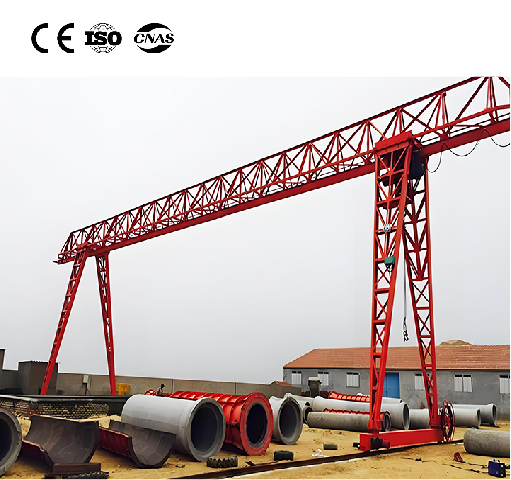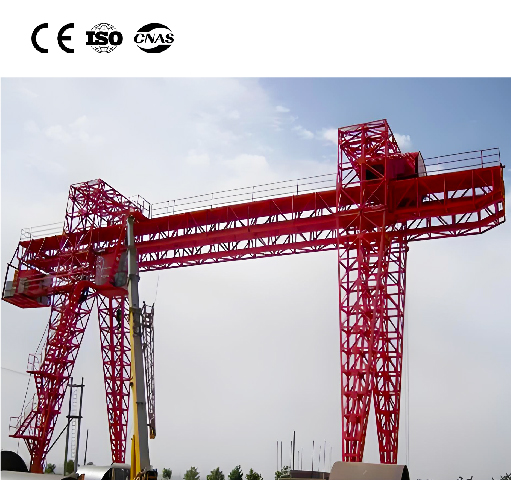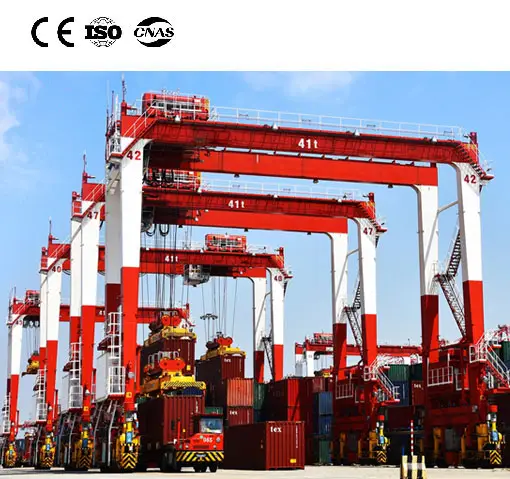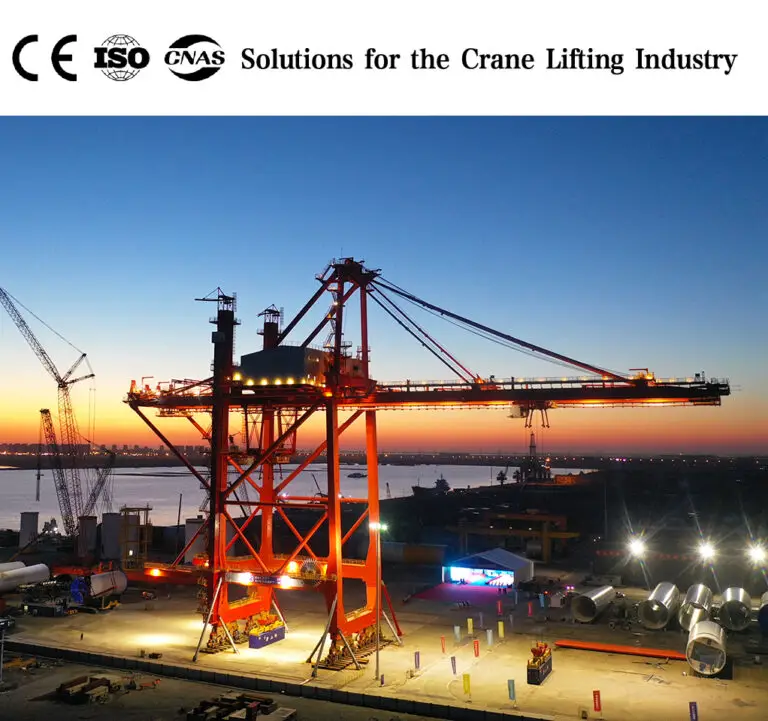In the field of outdoor material handling—from construction sites to open-air storage yards—single girder truss gantry cranes stand as flexible, cost-efficient solutions. Unlike overhead single girder truss cranes (suspended from building structures), these gantry models feature a single truss beam supported by ground-mounted legs and run on floor rails, eliminating reliance on systems. Ideal for light-to-medium outdoor lifting (1–30 tons, spans of 10–35 meters), they fill a critical gap for operations where overhead infrastructure is unavailable.

1. What Is a Single Girder Truss Gantry Crane?
A single girder truss gantry crane is a ground-mounted lifting system built around a single load-bearing truss beam (composed of triangular steel units) supported by two or four vertical legs. Unlike overhead cranes, it travels on rails installed directly on the ground (or concrete foundations), making it independent of building structures. This design balances structural efficiency (truss reduces weight) and outdoor adaptability (ground rails enable wide coverage).
Key components that define its functionality:
- Truss Beam: The core load-bearing structure (typically Q235/Q355 steel), 10–35 meters in span. The truss design cuts self-weight by 25%–30% vs. solid single-girder beams, lowering rail and foundation costs.
- Ground-Mounted Legs: Two (or four for extra stability) steel legs connecting the truss beam to the end trucks. Leg height ranges from 3–8 meters, accommodating loads like stacked containers or tall machinery.
- End Trucks & Rails: Wheel-equipped end trucks (mounted at the base of legs) run on parallel ground rails (6–12 meters wide), enabling the crane to cover large outdoor areas (e.g., 100+ meters of rail for storage yards).
- Hoist & Trolley: An underslung trolley (mounted beneath the truss beam) carries an electric chain/wire rope hoist (1–30 tons). Most hoists include variable speed controls (0.3–12 m/min) for precise outdoor lifting.
- Outdoor-Ready Controls: Weatherproof pendant or wireless remote controls (IP65-rated) with safety features—overload protection, emergency stop, and wind speed sensors (for high-wind regions).
Its defining trait: Independence from overhead structures—critical for outdoor sites like construction yards, port storage areas, or factories without dedicated crane-supporting buildings.
2. Core Advantages of Single Girder Truss Gantry Cranes
Single girder truss gantry cranes excel in outdoor light-to-medium lifting, offering unique benefits that set them apart from overhead or double-girder gantry alternatives:
2.1 Low Infrastructure Dependence & Cost
- No Building Modifications: Unlike overhead cranes, they require no 厂房 beams or ceiling supports—ideal for greenfield sites or temporary projects (e.g., highway construction). Foundation costs are minimal: a 10-ton model needs only reinforced concrete rails (≈$20–$30 per meter) vs. $5,000+ for overhead crane supports.
- Affordable Procurement: With one truss beam and simplified legs, they cost 35%–45% less than double girder truss gantry cranes. For example, a 10-ton, 15-meter span model ranges from $8,000–$15,000, vs. $18,000–$30,000 for a double girder alternative.
2.2 Outdoor Durability
- Weather Resistance: Standard models include anti-corrosion coatings (zinc-plated or epoxy-painted) for rain/salt spray, while premium versions use marine-grade steel (316L) for coastal ports. Electrical components (motors, controls) are IP65-rated to withstand dust, rain, and temperature swings (-20°C to 60°C).
- Wind Stability: Optional wind bracing (for legs) and wind speed sensors (automatic shutdown at >22 m/s) prevent tipping in outdoor gusts—critical for open yards or coastal sites.
2.3 Flexible Coverage & Adaptability
- Wide Rail Coverage: Ground rails can be extended to 100+ meters, enabling the crane to service large storage areas (e.g., a 200-meter rail for a steel coil yard). Rails are easy to relocate for temporary projects (e.g., 6-month construction sites).
- Adjustable Leg Height: Legs can be customized (3–8 meters) to handle tall loads—e.g., 5-meter legs for stacking 2x 40-foot containers (≈4.8 meters tall) or 8-meter legs for lifting tall machinery (e.g., 7-meter construction excavators).
2.4 Easy Installation & Operation
- Fast Setup: A 10-ton model takes 2–4 days to install (rails + crane assembly) vs. 7–10 days for double girder gantries. No specialized lifting equipment is needed—most components weigh <1 ton.
- Intuitive Controls: Wireless remotes (range: 50–100 meters) let operators stand clear of loads, improving safety in busy outdoor sites. Minimal training is required (1–2 days) vs. 3–5 days for complex double girder models.
3. Key Applications of Single Girder Truss Gantry Cranes
Single girder truss gantry cranes are tailored to outdoor and ground-mounted lifting scenarios, with applications spanning industries where overhead infrastructure is impractical:
3.1 Open-Air Storage Yards
- Steel/Metal Storage: Lifting 5–20 ton steel coils, I-beams, or pipe sections in metal yards. A steel distributor in Texas uses 4 single girder truss gantry cranes (15-ton, 20-meter span) to move coils between railcars and storage racks.
- Container Yards: Handling 10–30 ton 20/40-foot containers in small-to-medium ports or inland depots. The adjustable trolley and wide rail coverage enable stacking containers 2–3 high.
3.2 Construction & Infrastructure Projects
- Highway/Bridge Construction: Lifting 3–15 ton precast concrete beams, steel girders, or construction machinery (e.g., bulldozers) at job sites. A bridge construction project in Florida uses a 12-ton, 25-meter span model to place 10-ton concrete segments.
- Building Construction: Moving 2–8 ton building materials (e.g., steel frames, HVAC units) to upper floors of low-rise buildings (3–5 stories). The ground rails can be adjusted as the project expands.
3.3 Manufacturing & Industrial Outdoor Areas
- Heavy Machinery Assembly: Lifting 8–25 ton engine blocks, chassis, or large components in outdoor assembly areas (e.g., agricultural tractor factories). A tractor manufacturer in Illinois uses a 20-ton, 30-meter span model to assemble 18-ton tractor frames.
- Wastewater Treatment Plants: Handling 5–12 ton pumps, filters, or tank components in outdoor treatment areas. Corrosion-resistant models (epoxy coating + stainless steel parts) withstand moisture and chemical exposure.
3.4 Logistics & Distribution Centers
- Outdoor Pallet Storage: Lifting 1–5 ton palletized goods (e.g., bulk food, consumer goods) in open-air distribution yards. The crane’s wide coverage reduces the need for multiple forklifts, cutting labor costs by 20%.
- Railcar Loading/Unloading: Moving 5–15 ton cargo (e.g., grain, fertilizer) between railcars and trucks in outdoor rail yards. The variable speed hoist prevents spillage of bulk materials.
4. Critical Factors for Selecting a Single Girder Truss Gantry Crane
Choosing the right model requires aligning it with outdoor site conditions, load needs, and long-term usability. Below are the most important considerations:
4.1 Load Requirements & Safety Margins
- Rated Load: Calculate your maximum typical load (e.g., 8 tons for construction beams, 20 tons for containers). Add a 15%–20% safety margin (e.g., a 23-ton crane for 20-ton containers) to account for outdoor load instability (e.g., wind-induced sway).
- Load Type: For bulky loads (e.g., containers), select a crane with a spreader beam attachment. For fragile loads (e.g., precast concrete), opt for a hoist with soft-start/stop controls to avoid impact.
4.2 Site & Environmental Conditions
- Ground Flatness: The site must have level ground (±5mm per meter) for rail installation. Uneven ground requires grading (cost: $1–$3 per square meter) or adjustable leg feet (to compensate for 10–15mm slopes).
- Outdoor Hazards:
- Coastal/Saltwater: Choose marine-grade steel (316L) and anti-corrosion coatings to prevent rust (adds 10%–15% to cost but extends lifespan by 5–7 years).
- High-Wind Areas: Select wind bracing for legs and wind speed sensors (automatic shutdown at >22 m/s) to avoid tipping.
- Cold Climates: Opt for low-temperature lubricants (-30°C to 40°C) and heated electrical enclosures to prevent freezing.
4.3 Span & Rail Configuration
- Span Length: Measure the width of the area to cover (e.g., 15 meters for a single railcar, 30 meters for two parallel storage rows). Standard spans are 10–35 meters; custom spans up to 40 meters are available from manufacturers like ABUS or Konecranes.
- Rail Type: Choose between concrete-embedded rails (permanent sites, cost: $25–$40 per meter) or temporary steel rails (portable sites, cost: $15–$25 per meter). Ensure rail spacing matches the crane’s wheelbase (typically 1.5–3 meters).
4.4 Work Class & Duty Cycle
- Work Class (ISO 4301):
- A1–A2 (Light Duty): 0.5–1 hour/day (e.g., occasional container moves).
- A3–A4 (Medium Duty): 2–6 hours/day (e.g., daily construction lifting).
- A5 (Heavy Light Duty): 6–10 hours/day (e.g., high-volume storage yard operations).
- Duty Cycle: Calculate lifts per hour (e.g., 3–5 lifts/hour for medium duty, 8–12 lifts/hour for heavy light duty). High-duty cycles require reinforced truss nodes and IP54-rated motors (dust/water resistant).
5. Maintenance Best Practices for Single Girder Truss Gantry Cranes
Outdoor conditions (rain, dust, temperature swings) accelerate wear—proactive maintenance extends lifespan to 12–18 years (vs. 8–10 years for neglected models):
5.1 Daily Inspections (10–15 Minutes/Shift)
- Rail & End Trucks: Check rails for debris (e.g., dirt, rocks) and alignment (replace damaged rail sections if bent >3mm). Inspect end truck wheels for wear (tread depth <8mm requires replacement) and loose bolts.
- Truss Beam & Legs: Look for loose truss bolts (tighten with torque wrench to 40–60 N·m for M12 bolts) and leg bracing cracks (focus on leg-to-beam connections).
- Hoist & Controls: Test hoist brakes (hold a full load for 5 minutes without slipping) and weatherproof controls (ensure no water ingress in pendant/remote).
5.2 Weekly/Monthly Preventive Maintenance
- Weekly: Lubricate end truck wheels and trolley gears with lithium-based grease (e.g., Mobilux EP 2) — outdoor dust requires more frequent lubrication (every 50 hours vs. 100 hours indoors). Clean truss beams with a pressure washer to remove dirt/salt.
- Monthly: Inspect electrical connections (wiring, terminals) for corrosion—use dielectric grease to protect connections. Check anti-corrosion coatings (touch up chipped paint with epoxy to prevent rust).
5.3 Annual Overhaul (2–3 Days)
- Component Replacement: Replace worn parts: brake pads (every 1,500 hours), hoist chain links (stretched >3%), and rail fasteners (rusted or loose).
- Load Testing: Conduct a static load test with 125% of rated capacity (e.g., 12.5 tons for 10-ton cranes) to verify truss/leg integrity. Use certified test weights and document results.
- Weatherproofing Upgrade: Apply a fresh coat of anti-corrosion paint to legs and truss beams (every 2 years for coastal sites) and replace worn weather seals on electrical enclosures.
5.4 Seasonal Maintenance
- Winter Prep: Replace lubricants with low-temperature grades (-30°C) and install heated enclosures for controls (if temperatures drop below -10°C).
- Summer Prep: Clean motor cooling fans (dust buildup reduces efficiency) and check wind speed sensors (calibrate to ensure accurate shutdown triggers).
- Coastal Seasonal Care: Rinse legs/rails with fresh water monthly to remove salt residue (prevents galvanic corrosion).
6. Future Trends in Single Girder Truss Gantry Cranes
The industry is evolving to meet the demand for smarter, more sustainable outdoor lifting:
6.1 IoT-Enabled Outdoor Monitoring
- Remote Condition Tracking: Manufacturers like Demag now offer models with IoT sensors that monitor leg stress, rail alignment, and hoist temperature. Data is sent to cloud platforms (e.g., Demag Smart Control) for real-time alerts—reducing unplanned downtime by 35%.
- Wind & Weather Adaptation: AI-powered systems adjust lifting speed based on real-time wind data (e.g., slow hoist speed to 2 m/min if winds exceed 15 m/s) to prevent load sway.
6.2 Green & Portable Solutions
- Battery-Powered Hoists: Lithium-ion battery hoists (8–12 hour run time) replace electric models for sites without grid power (e.g., remote construction sites). Solar panels (mounted on truss beams) can recharge batteries, cutting fuel costs for generators.
- Modular/Portable Designs: Foldable legs and lightweight truss sections (aluminum-steel hybrid) reduce transport size by 50%—ideal for temporary projects (e.g., 3-month road construction).
6.3 Automation for Outdoor Efficiency
- Semi-Autonomous Operation: GPS-guided trolleys and AI load positioning enable semi-automatic container stacking (error rate <1% vs. 5% for manual operation). Useful for large storage yards with repetitive tasks.
- Fleet Integration: Multiple cranes can be controlled from a central dashboard (e.g., for a 5-crane steel yard), optimizing coverage and reducing operator labor by 40%.
Conclusion
Single Girder Truss Gantry Cranes are the go-to solution for outdoor light-to-medium lifting—offering independence from overhead structures, outdoor durability, and cost efficiency. By focusing on site conditions (ground flatness, weather), matching load needs to crane specs, and following outdoor-specific maintenance, you can maximize productivity and extend lifespan.




